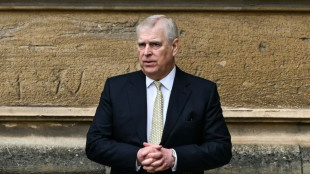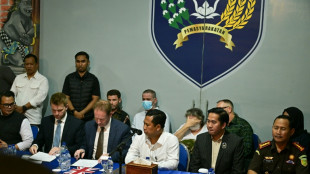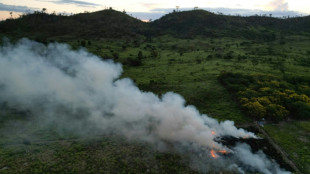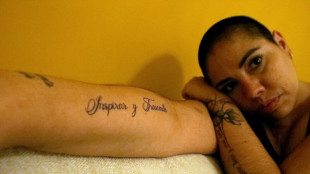
-
 Scandic Trust Group strengthens sales network with First Idea Consultant
Scandic Trust Group strengthens sales network with First Idea Consultant
-
US officials, NGOs cry foul as Washington snubs UN rights review

-
 Injured teen medal hope Tabanelli risks missing home Winter Olympics
Injured teen medal hope Tabanelli risks missing home Winter Olympics
-
Bellingham, Foden recalled to England squad for World Cup qualifiers

-
 Tanzania rights group condemns 'reprisal killings' of civilians
Tanzania rights group condemns 'reprisal killings' of civilians
-
Slot urges patience as Isak returns to training with Liverpool

-
 Rees-Zammit set for Wales return with bench role against Argentina
Rees-Zammit set for Wales return with bench role against Argentina
-
China's new aircraft carrier enters service in key move to modernise fleet

-
 Operation Cloudburst: Dutch train for 'water bomb' floods
Operation Cloudburst: Dutch train for 'water bomb' floods
-
Leaders turn up the heat on fossil fuels at Amazon climate summit

-
 US travel woes mount as govt shutdown prompts flight cuts
US travel woes mount as govt shutdown prompts flight cuts
-
North Korea fires unidentified ballistic missile: Seoul military

-
 West Bank's ancient olive tree a 'symbol of Palestinian endurance'
West Bank's ancient olive tree a 'symbol of Palestinian endurance'
-
Global tech tensions overshadow Web Summit's AI and robots

-
 Green shines as Suns thump Clippers 115-102
Green shines as Suns thump Clippers 115-102
-
Japan to screen #MeToo film months after Oscar nomination

-
 Erasmus relishing 'brutal' France re-match on Paris return
Erasmus relishing 'brutal' France re-match on Paris return
-
Rejuvenated Vlahovic taking the reins for Juve ahead of Turin derby

-
 'Well-oiled' Leipzig humming along in Bayern's slipstream
'Well-oiled' Leipzig humming along in Bayern's slipstream
-
Bangladesh cricket probes sexual harassment claims

-
 NFL-best Broncos edge Raiders to win seventh in a row
NFL-best Broncos edge Raiders to win seventh in a row
-
Deadly Typhoon Kalmaegi ravages Vietnam, Philippines

-
 Three killed in new US strike on alleged drug boat, toll at 70
Three killed in new US strike on alleged drug boat, toll at 70
-
Chinese microdrama creators turn to AI despite job loss concerns

-
 Trump hails Central Asia's 'unbelievable potential' at summit
Trump hails Central Asia's 'unbelievable potential' at summit
-
Kolya, the Ukrainian teen preparing for frontline battle

-
 Big leap in quest to get to bottom of climate ice mystery
Big leap in quest to get to bottom of climate ice mystery
-
Markets drop as valuations and US jobs, rates spook investors

-
 'Soap opera on cocaine': how vertical dramas flipped Hollywood
'Soap opera on cocaine': how vertical dramas flipped Hollywood
-
Under pressure? EU states on edge over migrant burden-sharing

-
 US influencers falsely associate Mamdani with extremist group
US influencers falsely associate Mamdani with extremist group
-
Hungary's Orban to meet Trump in face of Russia oil sanctions

-
 US facing travel chaos as flights cut due to govt shutdown
US facing travel chaos as flights cut due to govt shutdown
-
Liverpool and Man City renew rivalry as they try to narrow Arsenal gap

-
 UK's Andrew asked to testify over Epstein as he formally loses titles
UK's Andrew asked to testify over Epstein as he formally loses titles
-
Local hero: 'DC sandwich guy' found not guilty of assaulting officer with sub

-
 Dead famous: Paris puts heritage graves up for grabs
Dead famous: Paris puts heritage graves up for grabs
-
UK grandmother on Indonesia death row flies home

-
 Former NFL star Brown extradited from Dubai to face trial in shooting - police
Former NFL star Brown extradited from Dubai to face trial in shooting - police
-
Primary Hydrogen Identifies Two High-Priority Ree Anomaly Clusters from Geophysical and Soil Sampling Survey at Wicheeda North Project

-
 How to Sell Your Small Business Fast (Guide Release)
How to Sell Your Small Business Fast (Guide Release)
-
Chile presidential hopeful vows to expel 'criminal' migrants to El Salvador

-
 Trump event paused in Oval Office when guest faints
Trump event paused in Oval Office when guest faints
-
NFL Colts add Sauce to recipe while Patriots confront Baker

-
 Home owned by Miami Heat coach Spoelstra damaged by fire
Home owned by Miami Heat coach Spoelstra damaged by fire
-
Tesla shareholders approve Musk's $1 trillion pay package

-
 World leaders launch fund to save forests, get first $5 bn
World leaders launch fund to save forests, get first $5 bn
-
Villa edge Maccabi Tel Aviv in fraught Europa League match

-
 Protests as Villa beat Maccabi Tel Aviv under tight security
Protests as Villa beat Maccabi Tel Aviv under tight security
-
US Supreme Court backs Trump admin's passport gender policy


No longer a death sentence: Four decades of living with HIV
Forty years after the discovery of HIV, AFP looks at how far we have come in fighting a deadly virus that was once shrouded in fear and shame but is now treated as a manageable chronic condition.
- 1981: First alert -
In June 1981, US epidemiologists report five cases of a rare form of pneumonia in gay men in California.
It is the first alert about Acquired Immune Deficiency Syndrome (AIDS), still unknown and unnamed.
Doctors then identify "opportunistic infections" among intravenous drug users and in haemophiliacs and Haitian residents in the United States.
The term AIDS appears for the first time in 1982. The disease is wrongly presented as a "homosexual disorder".
- 1983: Identifying HIV -
In January 1983, researchers in France, Francoise Barre-Sinoussi and Jean-Claude Chermann, working under Luc Montagnier, identify the virus that "might be" responsible for AIDS.
Their discovery is published on May 20 in the journal Science.
The following year, US specialist Robert Gallo is said to have found the "probable" cause of AIDS, the retrovirus HTLV-III.
The two viruses turn out to be the same, and in May 1986 it becomes officially known as the Human Immunodeficiency Virus, or HIV.
- 1987: Anti-retroviral treatment -
In March 1987, the first anti-retroviral treatment known as AZT is authorised in the US. It is expensive and has severe side effects.
The United States and France agree that Gallo and Montagnier should get joint credit for discovering HIV. But the 2008 Nobel prize goes to Barre-Sinoussi and Montagnier.
- Early 1990s: Fallen stars -
In July 1985, US actor Rock Hudson announces he has AIDS. His death three months later is the first high-profile AIDS death.
A host of other stars succumb to the disease, including legendary pianist Liberace (February 1987), British singer and Queen frontman Freddie Mercury (November 1991), and the Russian dancer and choreographer Rudolf Nureyev (January 1993).
In 1994, AIDS becomes the leading cause of death among Americans aged between 25 and 44.
- 1995-96: New approach -
Two new classes of drugs signal the start of combinations of different anti-retroviral therapies.
Called tri-therapies, they provide the first effective treatment for HIV.
1996 is the first year in which the number of AIDS deaths declines in the United States. While US numbers decline, they rocket in Africa, where AIDS is the biggest killer by 1999.
- 2001: Generic medicine -
In 2000, UNAIDS and five major drug companies sign a deal to distribute affordable treatments in poorer countries.
A year later, the World Trade Organization changes intellectual property rules to allow developing countries to make generic versions of patent-protected HIV treatments.
In 2004, the country with the world's highest HIV caseload, South Africa, ends years of AIDS denialism and makes anti-retroviral treatments available through the public health system.
- 2010: First cure -
Timothy Ray Brown, an American man who had been living with HIV for over a decade, is cured of the virus after undergoing cancer treatment.
Brown underwent two bone marrow transplants containing a mutation of a gene that blocks HIV from attacking host cells.
- 2012: Preventive pill -
In July 2012, the first-ever daily pill to help prevent HIV infection is approved by US regulators. Truvada is a pre-exposure prophylaxis, or PrEP, taken by high-risk people who are HIV-negative in order to prevent them from being infected.
- 2017: Treatment spreads -
For the first time, more than half of all people living with HIV are receiving anti-retroviral treatment.
The proportion rises to three-quarters: 28.7 million people are being treated out of 38.4 million who are infected, according to UNAIDS in 2021.
- 2020-2021: Covid setback -
The Covid-19 pandemic disrupts access to health systems, testing and treatment, slowing progress in the fight against AIDS, which in 40 years has killed 40.1 million people.
In 2021, 650,000 AIDS deaths and 1.5 million new infections are recorded.
UNAIDS hopes to end AIDS as a public health threat by 2030.
A.Mahlangu--AMWN



